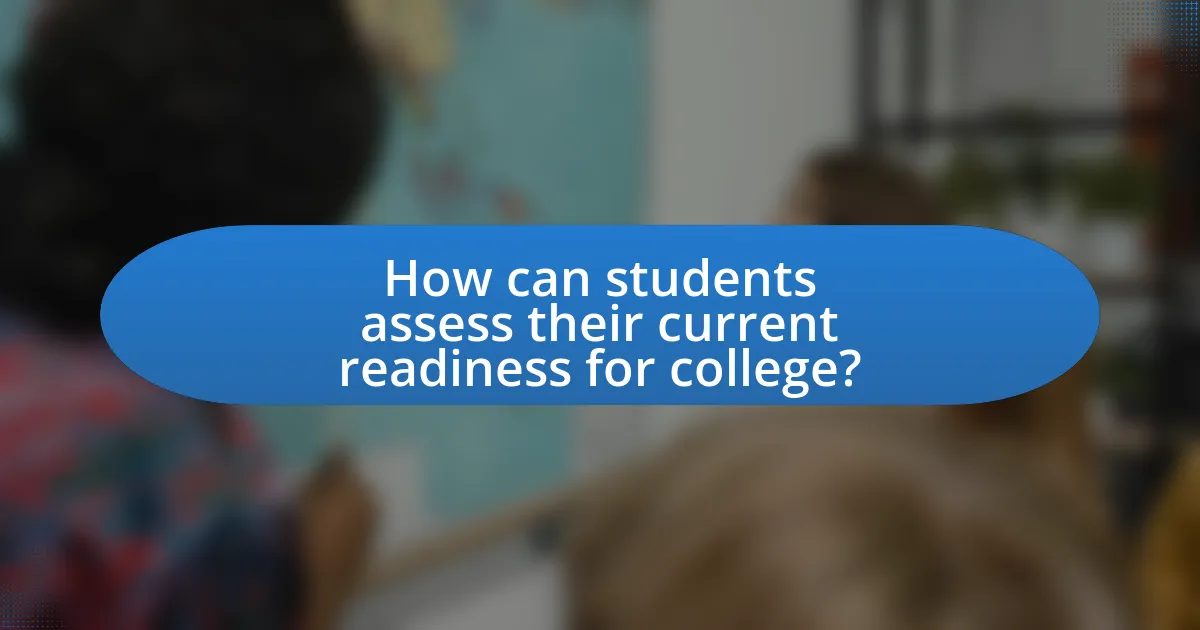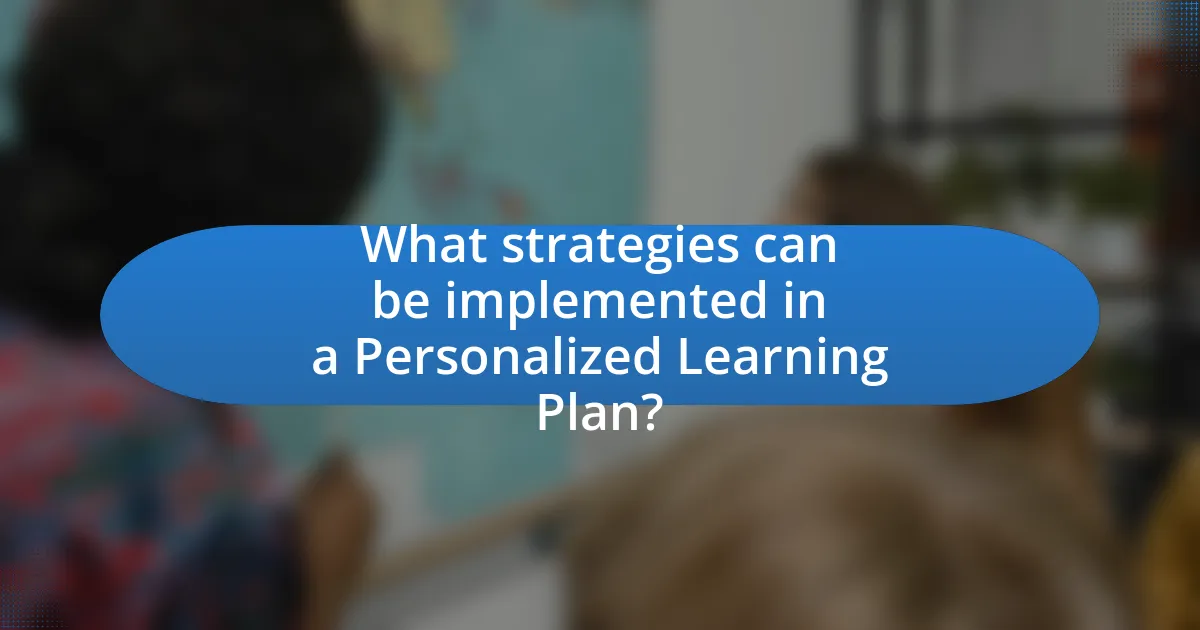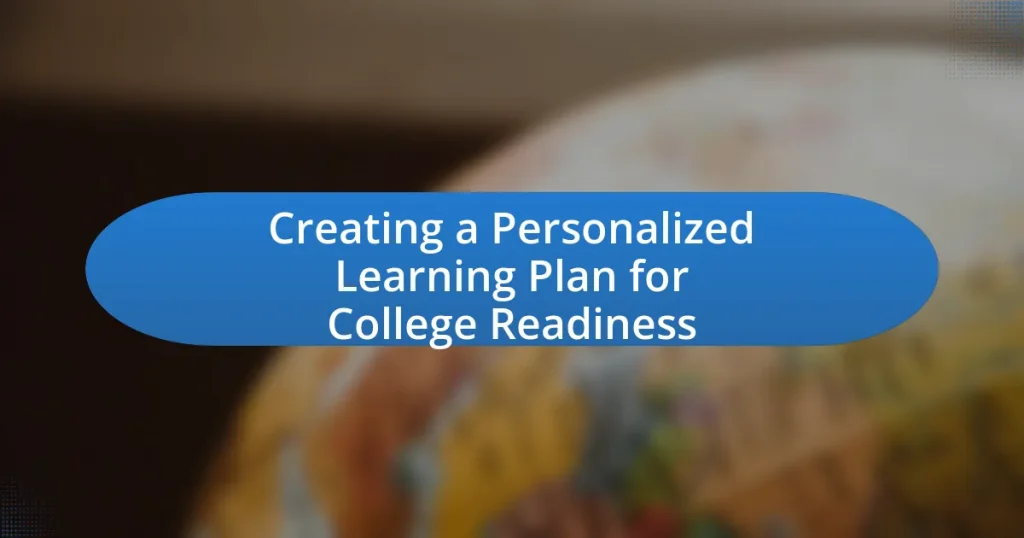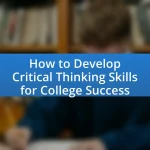A Personalized Learning Plan for College Readiness is a customized educational strategy that addresses the unique needs, strengths, and goals of individual students as they prepare for higher education. This article outlines the differences between personalized learning and traditional approaches, emphasizing the importance of tailored instructional strategies, ongoing assessments, and student engagement. Key elements of a successful Personalized Learning Plan include setting specific goals, utilizing technology, and incorporating mentorship, all aimed at enhancing student motivation and academic outcomes. Additionally, the article discusses methods for assessing college readiness, tracking progress, and overcoming challenges, providing a comprehensive framework for students to achieve their educational aspirations.

What is a Personalized Learning Plan for College Readiness?
A Personalized Learning Plan for College Readiness is a tailored educational strategy designed to meet the individual needs, strengths, and goals of a student in preparation for college. This plan typically includes specific academic objectives, learning activities, and assessments that align with the student’s interests and career aspirations. Research indicates that personalized learning approaches can significantly enhance student engagement and achievement, as evidenced by a study from the Bill & Melinda Gates Foundation, which found that personalized learning can lead to improved academic outcomes and better preparation for post-secondary education.
How does a Personalized Learning Plan differ from traditional learning approaches?
A Personalized Learning Plan (PLP) differs from traditional learning approaches by tailoring educational experiences to individual student needs, preferences, and goals, rather than applying a one-size-fits-all curriculum. Traditional learning typically follows a standardized curriculum where all students progress through the same material at the same pace, often leading to disengagement for those who may require different learning strategies or pacing. In contrast, PLPs utilize assessments and student input to create customized pathways that can include varied instructional methods, resources, and timelines, thereby enhancing student engagement and ownership of their learning process. Research indicates that personalized learning can lead to improved academic outcomes, as evidenced by a study from the Bill & Melinda Gates Foundation, which found that schools implementing personalized learning saw significant gains in student achievement compared to traditional methods.
What are the key elements of a Personalized Learning Plan?
The key elements of a Personalized Learning Plan include individualized learning goals, tailored instructional strategies, ongoing assessment, and student engagement. Individualized learning goals are specific objectives set for each student based on their unique needs and aspirations, ensuring that the learning process is relevant and focused. Tailored instructional strategies involve customizing teaching methods and resources to match the learning styles and preferences of each student, which enhances comprehension and retention. Ongoing assessment is crucial for monitoring progress and adjusting the learning plan as needed, allowing for timely interventions and support. Finally, student engagement emphasizes the importance of involving students in their own learning process, fostering ownership and motivation. These elements collectively contribute to a more effective and responsive educational experience, ultimately preparing students for college readiness.
Why is personalization important in preparing for college?
Personalization is important in preparing for college because it tailors the educational experience to individual student needs, enhancing engagement and effectiveness. Research indicates that personalized learning approaches can lead to improved academic outcomes; for instance, a study by the Bill & Melinda Gates Foundation found that personalized learning can increase student achievement by 3 to 5 percentile points. By addressing unique strengths, weaknesses, and interests, personalized learning plans help students develop the skills and confidence necessary for college success.
What are the goals of creating a Personalized Learning Plan?
The goals of creating a Personalized Learning Plan (PLP) include tailoring educational experiences to meet individual student needs, enhancing engagement, and improving academic outcomes. A PLP aims to identify specific learning objectives based on a student’s strengths, weaknesses, interests, and career aspirations, thereby fostering a more effective and relevant learning environment. Research indicates that personalized learning approaches can lead to increased motivation and achievement, as evidenced by a study from the Bill & Melinda Gates Foundation, which found that personalized learning can significantly improve student performance in various educational settings.
How can a Personalized Learning Plan enhance student engagement?
A Personalized Learning Plan enhances student engagement by tailoring educational experiences to individual learning styles, interests, and goals. This customization fosters a sense of ownership and relevance in students, making them more invested in their learning process. Research indicates that when students have a say in their learning paths, they are more likely to participate actively and persist through challenges. For instance, a study by the Bill & Melinda Gates Foundation found that personalized learning approaches can lead to increased motivation and improved academic outcomes, demonstrating the effectiveness of such plans in engaging students.
What skills does a Personalized Learning Plan aim to develop for college readiness?
A Personalized Learning Plan aims to develop critical thinking, self-regulation, and effective communication skills for college readiness. These skills are essential as they enable students to analyze complex problems, manage their learning processes, and articulate their ideas clearly. Research indicates that students who engage in personalized learning experiences demonstrate improved academic performance and greater preparedness for the demands of higher education, as evidenced by studies showing that tailored educational approaches lead to higher retention rates and better overall outcomes in college settings.

How can students assess their current readiness for college?
Students can assess their current readiness for college by evaluating their academic performance, skills, and personal attributes. This assessment can include reviewing high school grades, standardized test scores, and completion of college preparatory courses. Additionally, students should reflect on their time management, study habits, and ability to work independently, as these factors significantly impact college success. Research indicates that students who engage in self-assessment and seek feedback from teachers or counselors are better prepared for the transition to college, as they can identify areas needing improvement and develop targeted strategies to enhance their readiness.
What tools can students use to evaluate their academic strengths and weaknesses?
Students can use various tools to evaluate their academic strengths and weaknesses, including self-assessment questionnaires, standardized tests, and academic performance tracking software. Self-assessment questionnaires, such as the Learning Styles Inventory, help students identify their preferred learning methods and areas needing improvement. Standardized tests, like the SAT or ACT, provide benchmarks for academic performance relative to peers. Academic performance tracking software, such as Gradebook or Canvas, allows students to monitor their grades and identify subjects where they struggle. These tools collectively offer a comprehensive view of a student’s academic capabilities, enabling targeted improvements.
How do self-assessments contribute to the development of a Personalized Learning Plan?
Self-assessments significantly contribute to the development of a Personalized Learning Plan by enabling learners to identify their strengths, weaknesses, and learning preferences. This self-awareness allows for tailored educational strategies that align with individual needs, enhancing engagement and effectiveness. Research indicates that students who engage in self-assessment demonstrate improved academic performance and motivation, as they take ownership of their learning process. For instance, a study published in the “Journal of Educational Psychology” found that self-assessment practices lead to higher achievement levels among students, reinforcing the importance of incorporating self-assessments into personalized learning frameworks.
What role do standardized tests play in assessing college readiness?
Standardized tests serve as a critical tool in assessing college readiness by providing measurable data on a student’s academic skills and knowledge. These assessments, such as the SAT and ACT, evaluate competencies in areas like mathematics, reading, and writing, which are essential for success in higher education. Research indicates that students who perform well on these tests are more likely to succeed in college-level coursework, as evidenced by studies showing a correlation between standardized test scores and first-year college GPA. Additionally, standardized tests help colleges and universities make informed admissions decisions, ensuring that students possess the necessary skills to thrive in an academic environment.
How can students set effective goals within their Personalized Learning Plan?
Students can set effective goals within their Personalized Learning Plan by utilizing the SMART criteria, which stands for Specific, Measurable, Achievable, Relevant, and Time-bound. This framework ensures that goals are clearly defined and attainable within a set timeframe, enhancing focus and motivation. For instance, instead of a vague goal like “improve math skills,” a student could set a specific goal such as “achieve a score of 85% or higher on the next math exam within the next month.” Research indicates that students who set SMART goals are more likely to succeed academically, as they provide clear direction and measurable outcomes, fostering accountability and self-assessment.
What criteria should students use to establish SMART goals?
Students should use the SMART criteria to establish goals that are Specific, Measurable, Achievable, Relevant, and Time-bound. Specific goals clearly define what is to be achieved, such as improving a specific grade or mastering a particular skill. Measurable goals allow students to track progress through quantifiable indicators, like achieving a certain score on a test. Achievable goals ensure that the objectives are realistic and attainable given the student’s current resources and constraints. Relevant goals align with the student’s broader educational aspirations and personal interests, ensuring that the effort contributes to their overall success. Finally, Time-bound goals set a clear deadline for achievement, which helps maintain focus and motivation. This structured approach is supported by educational research, which indicates that goal-setting enhances student performance and accountability.
How can students prioritize their learning objectives for college readiness?
Students can prioritize their learning objectives for college readiness by assessing their academic strengths and weaknesses, setting specific goals, and aligning their coursework with college requirements. This process involves identifying key subjects that are essential for their intended college major and focusing on skills that enhance critical thinking, time management, and study habits. Research indicates that students who engage in self-assessment and goal-setting are more likely to succeed in college, as they develop a clearer understanding of what is necessary for their academic and career aspirations.

What strategies can be implemented in a Personalized Learning Plan?
Strategies that can be implemented in a Personalized Learning Plan include differentiated instruction, goal setting, and ongoing assessment. Differentiated instruction tailors teaching methods and resources to accommodate diverse learning styles and paces, ensuring that each student engages with the material effectively. Goal setting involves establishing specific, measurable, achievable, relevant, and time-bound (SMART) objectives that guide students in their learning journey, fostering motivation and accountability. Ongoing assessment provides continuous feedback on student progress, allowing for timely adjustments to the learning plan based on individual performance and needs. These strategies collectively enhance student engagement and improve educational outcomes, as supported by research indicating that personalized approaches lead to higher academic achievement and greater student satisfaction.
How can technology enhance a Personalized Learning Plan?
Technology can enhance a Personalized Learning Plan by providing tailored educational experiences that adapt to individual learning styles and paces. For instance, adaptive learning platforms utilize algorithms to assess a student’s strengths and weaknesses, allowing for customized content delivery that meets specific needs. Research from the Bill & Melinda Gates Foundation indicates that personalized learning approaches can lead to improved student engagement and achievement, with 70% of educators reporting positive impacts on student outcomes when using technology-driven personalized learning tools.
What are some effective educational tools and resources for personalized learning?
Effective educational tools and resources for personalized learning include adaptive learning platforms, learning management systems, and digital content libraries. Adaptive learning platforms, such as DreamBox and Knewton, tailor educational experiences to individual student needs by analyzing performance data and adjusting content accordingly. Learning management systems like Canvas and Google Classroom facilitate personalized learning by allowing educators to customize course materials and track student progress. Digital content libraries, such as Khan Academy and Coursera, provide a wide range of resources that students can access at their own pace, further supporting personalized learning. These tools enhance engagement and improve learning outcomes by catering to diverse learning styles and paces.
How can online courses be integrated into a Personalized Learning Plan?
Online courses can be integrated into a Personalized Learning Plan by aligning course content with individual learning goals and preferences. This integration allows students to select online courses that match their specific academic needs, interests, and pace of learning, thereby enhancing engagement and effectiveness. For instance, a study by the U.S. Department of Education found that personalized learning approaches, including the use of online courses, can lead to improved student outcomes, as they cater to diverse learning styles and provide flexibility in scheduling. By incorporating assessments and feedback mechanisms, educators can further tailor online course selections to ensure they meet the evolving needs of each student within their Personalized Learning Plan.
What role does mentorship play in a Personalized Learning Plan?
Mentorship plays a crucial role in a Personalized Learning Plan by providing guidance, support, and accountability tailored to individual learning needs. Mentors help students identify their strengths and weaknesses, set realistic goals, and develop strategies to achieve them. Research indicates that students with mentors are more likely to stay engaged in their education and achieve higher academic outcomes, as mentorship fosters a sense of belonging and motivation. For instance, a study by the National Mentoring Partnership found that mentored students are 55% more likely to enroll in college and 78% more likely to volunteer regularly in their communities, demonstrating the positive impact of mentorship on educational trajectories.
How can students find mentors to support their college readiness journey?
Students can find mentors to support their college readiness journey by leveraging school resources, community organizations, and online platforms. Schools often have guidance counselors who can connect students with mentors, while community organizations frequently offer mentorship programs tailored to educational goals. Additionally, online platforms like LinkedIn and mentorship-specific websites allow students to search for professionals in their fields of interest, facilitating connections that can enhance their college readiness. Research indicates that mentorship significantly improves academic performance and college enrollment rates, underscoring the importance of finding the right support.
What are the benefits of having a mentor during the planning process?
Having a mentor during the planning process provides invaluable guidance and support, enhancing the effectiveness of creating a personalized learning plan for college readiness. Mentors offer expertise and insights that help individuals navigate complex decisions, identify strengths and weaknesses, and set realistic goals. Research indicates that mentorship can lead to improved academic performance and increased confidence, as evidenced by a study published in the Journal of Educational Psychology, which found that students with mentors reported higher levels of motivation and engagement in their learning processes. This support system not only fosters accountability but also encourages the development of critical thinking and problem-solving skills essential for success in college.

How can students monitor their progress in a Personalized Learning Plan?
Students can monitor their progress in a Personalized Learning Plan by utilizing specific assessment tools and tracking methods. These tools include regular quizzes, self-assessments, and progress tracking software that provide real-time feedback on learning objectives. For instance, research indicates that students who engage in self-assessment are more likely to identify their strengths and weaknesses, leading to improved academic performance. Additionally, educators can facilitate progress monitoring through scheduled check-ins and personalized feedback sessions, ensuring that students remain aligned with their learning goals. This structured approach allows for continuous adjustment of the learning plan based on the student’s evolving needs and achievements.
What methods can be used to track academic progress and achievements?
Methods to track academic progress and achievements include formative assessments, summative assessments, portfolios, and learning management systems. Formative assessments, such as quizzes and class discussions, provide ongoing feedback that helps educators and students identify areas for improvement. Summative assessments, like final exams and standardized tests, evaluate student learning at the end of an instructional unit. Portfolios compile a student’s work over time, showcasing their skills and growth. Learning management systems, such as Canvas or Blackboard, allow for tracking grades, assignments, and student engagement, providing a comprehensive view of academic performance. These methods are widely recognized in educational research for their effectiveness in monitoring student progress and informing instructional strategies.
How can regular reflections and adjustments improve the learning plan?
Regular reflections and adjustments enhance the learning plan by ensuring it remains aligned with the learner’s evolving needs and goals. This iterative process allows for the identification of strengths and weaknesses, enabling targeted interventions that improve learning outcomes. Research indicates that reflective practices can lead to a 20% increase in academic performance, as they encourage deeper engagement with the material and foster self-regulation skills. By regularly assessing progress and making necessary adjustments, learners can optimize their strategies, ultimately leading to greater college readiness.
What indicators should students look for to assess their readiness for college?
Students should look for academic performance, time management skills, and social-emotional readiness to assess their readiness for college. Academic performance can be evaluated through GPA, standardized test scores, and coursework rigor, indicating a student’s ability to handle college-level material. Time management skills are crucial, as students need to balance coursework, extracurricular activities, and personal responsibilities; effective time management often correlates with successful college students. Social-emotional readiness involves resilience, self-motivation, and the ability to seek help when needed, which are essential for navigating the challenges of college life. Research shows that students who demonstrate these indicators are more likely to succeed in higher education environments.
What are some common challenges in creating a Personalized Learning Plan?
Common challenges in creating a Personalized Learning Plan include identifying individual learning needs, ensuring engagement, and aligning resources effectively. Identifying individual learning needs can be difficult due to varying student backgrounds and learning styles, which complicates the assessment process. Ensuring engagement is challenging as students may lack motivation or interest in personalized content, leading to ineffective learning experiences. Additionally, aligning resources effectively requires adequate training for educators and access to appropriate tools, which may not always be available, hindering the implementation of personalized strategies.
How can students overcome obstacles in their learning journey?
Students can overcome obstacles in their learning journey by developing a personalized learning plan that addresses their unique challenges and goals. This approach allows students to identify specific barriers, such as time management or comprehension issues, and create targeted strategies to tackle them. Research indicates that personalized learning can lead to improved academic performance; for instance, a study by the Bill & Melinda Gates Foundation found that personalized learning initiatives can increase student engagement and achievement by tailoring educational experiences to individual needs. By actively engaging in self-assessment and seeking support from educators, peers, or resources, students can effectively navigate their learning obstacles and enhance their readiness for college.
What resources are available to assist students facing difficulties?
Students facing difficulties can access various resources, including academic tutoring services, counseling centers, and online learning platforms. Academic tutoring services provide personalized assistance in subjects where students struggle, enhancing their understanding and performance. Counseling centers offer mental health support and guidance, helping students manage stress and personal challenges that may affect their academic success. Online learning platforms, such as Khan Academy and Coursera, provide additional instructional materials and courses that cater to diverse learning needs, allowing students to learn at their own pace. These resources collectively support students in overcoming academic and personal obstacles, promoting their readiness for college.
What best practices should students follow when creating a Personalized Learning Plan?
Students should follow several best practices when creating a Personalized Learning Plan (PLP) to enhance their college readiness. First, they should set clear, achievable goals that align with their academic and career aspirations, ensuring that these goals are specific, measurable, attainable, relevant, and time-bound (SMART). This approach helps students maintain focus and track their progress effectively.
Next, students should assess their current skills and knowledge to identify strengths and areas for improvement. Conducting a self-assessment or utilizing tools like learning inventories can provide valuable insights into their learning preferences and gaps.
Additionally, students should incorporate diverse learning strategies tailored to their individual needs, such as project-based learning, collaborative activities, or online resources. Research indicates that personalized learning approaches can lead to improved engagement and academic performance.
Regularly reviewing and adjusting the PLP is also crucial. Students should schedule periodic check-ins to evaluate their progress and make necessary modifications based on their evolving goals and experiences. This iterative process ensures that the PLP remains relevant and effective.
Finally, seeking feedback from educators, mentors, or peers can provide external perspectives that enhance the quality of the PLP. Engaging with others fosters accountability and encourages continuous improvement.
How can students ensure their plan remains flexible and adaptable?
Students can ensure their plan remains flexible and adaptable by regularly reviewing and adjusting their goals based on progress and changing circumstances. This approach allows students to respond to new opportunities or challenges, such as shifts in academic interests or unexpected life events. Research indicates that adaptive learning strategies, which include self-assessment and feedback mechanisms, significantly enhance student engagement and success (Hattie, J. & Timperley, H., 2007, “The Power of Feedback,” Review of Educational Research). By incorporating these strategies, students can maintain a dynamic learning plan that evolves with their needs.
What tips can help students stay motivated throughout the process?
To stay motivated throughout the process of creating a personalized learning plan for college readiness, students should set specific, achievable goals. Research indicates that goal-setting enhances motivation by providing clear targets to strive for, which can lead to increased focus and persistence. Additionally, students can benefit from establishing a routine that includes regular study sessions, as consistency fosters discipline and reduces procrastination. Engaging with peers for support and accountability can also boost motivation, as collaborative learning environments encourage shared goals and mutual encouragement. Lastly, celebrating small achievements along the way reinforces progress and maintains enthusiasm, as positive reinforcement is known to enhance motivation levels.


